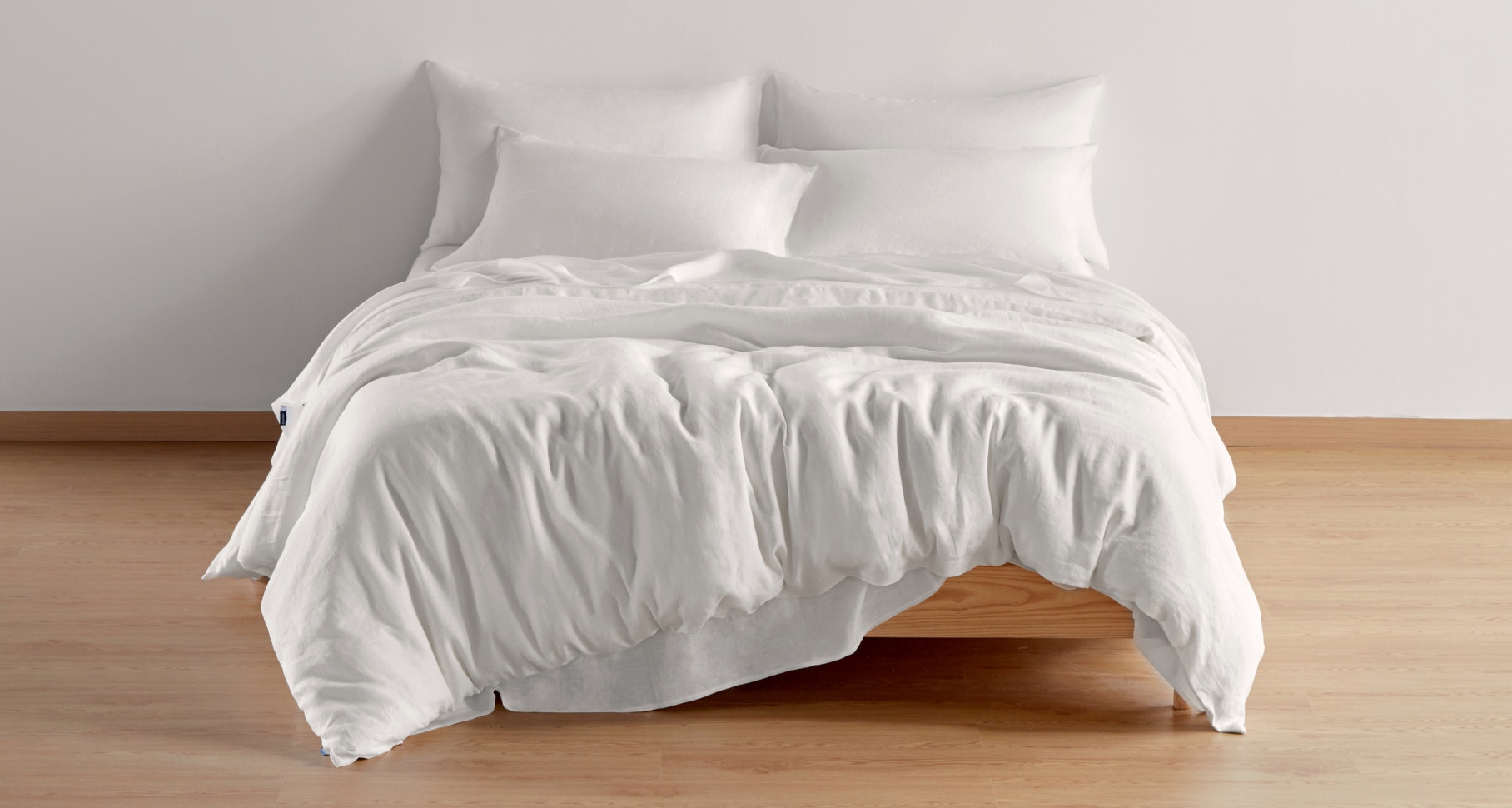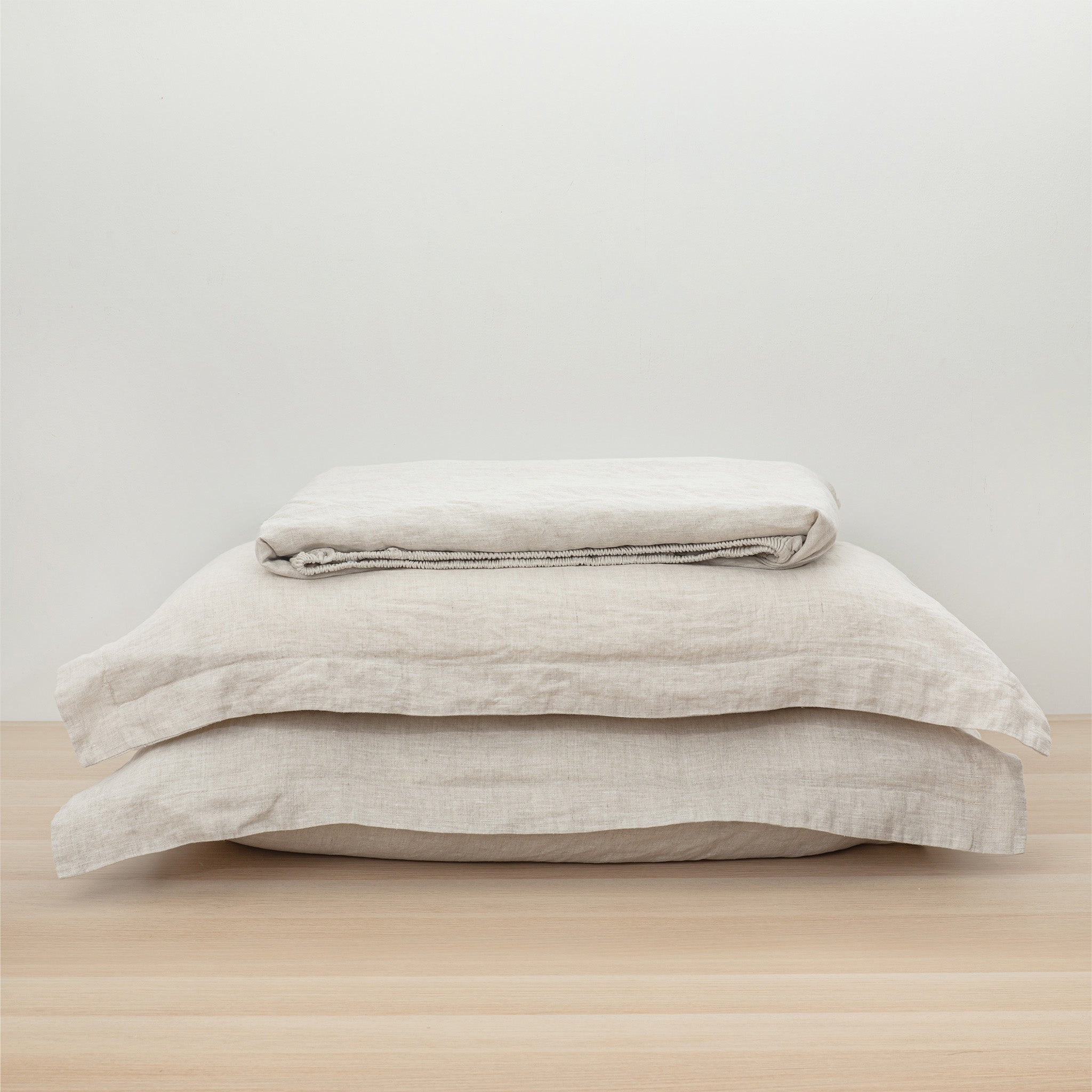Comprehending Bed Linen: The Eco-Friendly Option for Comfy Living
When you consider environment-friendly materials, bed linen frequently sticks out for its distinct qualities. This all-natural fabric, made from the flax plant, offers both convenience and sustainability. Its remarkable homes make it a perfect selection for warm climate and resilient usage. However what absolutely sets bed linen aside from various other materials? Understanding its advantages and origins can transform exactly how you view home fabrics. Allow's explore the interesting world of linen additionally.
The Beginnings of Bed Linen: From Flax to Textile

Linen, one of the oldest textiles understood to humankind, has an interesting journey that begins with the modest flax plant. Once harvested, the flax stalks undertake a procedure called retting, where they're soaked to divide the fibers from the woody components.
When you see bed linen textile, you're seeing centuries of workmanship. Bed linen has actually been cherished for its all-natural look and really feel, making it a preferred for whatever from clothing to home fabrics.
The Distinct Residence of Linen
Among the standout features of this impressive fabric is its breathability. When you wear linen, you'll notice just how it enables air to flow, keeping you cool down on hot days. This residential property makes it a perfect choice for summer garments and sheets.
Linen additionally flaunts remarkable moisture-wicking abilities, drawing sweat far from your skin and enabling it to vaporize quickly. You will not feel clammy, also in moist problems. Additionally, bed linen is long lasting, often becoming softer and extra comfy with each clean, which means it can stand the examination of time in your closet.
One more distinct facet is its natural appearance; the slight abnormalities offer linen a personality that enhances your style. Plus, it stands up to creases far better than numerous other fabrics, so you can delight in a relaxed yet polished appearance without much initiative. Embrace linen, and you'll appreciate its convenience and special appeal.
Environmental Benefits of Linen
When you select bed linen, you're not simply choosing for a beautiful material; you're additionally sustaining sustainable production techniques. Linen's eco-friendly and compostable nature makes it a smart option for the environment. And also, it calls for considerably much less water to produce compared to various other fabrics, aiding preserve this precious source.
Lasting Production Practices
Although numerous textiles have significant environmental effects, bed linen stands out as a result of its sustainable production methods. When you pick bed linen, you're choosing for a fabric made from the flax plant, which calls for marginal water and chemicals. This resilient crop can flourish in inadequate soil problems, decreasing the demand for chemical fertilizers. Furthermore, the whole flax plant is used in production, reducing waste and advertising resource performance.
Bed linen manufacturing is commonly less energy-intensive contrasted to various other textiles, as it includes all-natural procedures instead of artificial therapies. By supporting bed linen, you're adding to an extra sustainable textile industry that focuses on green techniques. Picking bed linen not only boosts your comfort but also straightens your values with environmental duty.
Biodegradable and Compostable Material
Linen's environmentally friendly nature prolongs beyond its sustainable manufacturing; it's additionally naturally degradable and compostable, making it an exceptional choice for ecologically mindful consumers. When you select linen products, you're opting for products that damage down normally, returning nutrients to the planet. This indicates that at the end of their life cycle, your linen items will not add to garbage dump waste. Rather, they can decay securely, decreasing your environmental footprint. In addition, composting linen can improve soil, promoting healthy and balanced plant development. By including linen into your home, you're not simply appreciating its comfort and durability; you're likewise sustaining green techniques and helping develop a healthier world. Embrace linen, and really feel good concerning your options for the atmosphere.
Low Tide Intake
One of the standout advantages of linen is its reduced water consumption throughout cultivation. Unlike cotton, which calls for significant irrigation, bed linen's flax plant flourishes on marginal water, making it a more lasting selection. You'll value knowing that for every load of linen created, substantially less water is needed compared to lots of various other fabrics.
Linen vs. Various Other Fabrics: A Comparison
When you contrast bed linen to other materials, you'll observe its remarkable breathability and convenience, making it ideal for cozy climate. And also, linen sticks out for its toughness and longevity, usually outlasting lots of frequently used products. As you consider your selections, the ecological impact of each material will certainly also play an important function in your choice.
Breathability and Convenience
Linen stands out among materials for its remarkable ability to enable air blood circulation. Unlike synthetic materials, which can trap Read More Here heat and moisture, linen's all-natural fibers wick away sweat, keeping you completely dry and great.
Cotton is usually applauded for its soft qualities, however it does not match bed linen's breathability. If you prioritize comfort, especially in summer, bed linen must be your go-to selection.
Resilience and Long Life
While lots of fabrics offer varying levels of sturdiness, linen genuinely succeeds in durability, making it a sensible investment for your closet. Unlike cotton or synthetic products that might break quickly, bed linen obtains stronger with each wash. Its natural fibers stand up to fraying and fading, guaranteeing your garments look wonderful gradually. You'll locate that linen's breathable nature also lowers wear from sweat and moisture, which can damage other textiles. Plus, its capability to withstand high temperature levels implies it will not shrink easily in the clothes dryer. When you choose linen, you're choosing a resilient material that can manage everyday usage while maintaining its appeal. Trust fund me, your long-lasting financial investment in bed linen will certainly settle with years of stylish, comfortable wear.
Environmental Impact Comparison
Although numerous materials add to ecological problems, bed linen stands out for its green top qualities. Unlike cotton, which calls for substantial water resources and chemicals, linen is made from flax, a plant that prospers on minimal water and requires less chemicals. This indicates you can really feel good regarding your choice while reducing your carbon footprint.
When compared to artificial textiles like polyester, bed linen's biodegradability beams. While polyester can take centuries to break down, linen breaks down normally, returning nutrients to the dirt.
Selecting linen not just advertises sustainable farming techniques yet also supports a healthier earth. By going with bed linen over standard materials, you're making a conscious choice that benefits both your comfort and the setting.
Caring for Your Linen Textiles
To assure your bed linen textiles continue to be in fantastic condition, you'll wish to comply with some straightforward treatment standards. First, wash your bed linen in chilly water on a gentle cycle to avoid it from diminishing or shedding its form. Stay clear of utilizing bleach, as it can damage the fibers. Rather, choose a light detergent that's devoid of harsh chemicals.
When it comes to drying, air drying out is finest. If you use a dryer, choose a low heat setup and remove the items while they're still somewhat damp to minimize wrinkles. Iron the linen while it's still damp for easier handling, or vapor it to maintain it looking crisp.
For storage space, keep your linen in an amazing, completely dry place. Stay clear of direct sunshine to stop fading. With these straightforward methods, your linen textiles will certainly maintain their charm and last for several years, making them a lasting addition to your lifestyle.
Integrating Linen Into Your Home Design
Taking care of your bed linen fabrics not just preserves their high quality but likewise opens a world of possibilities for integrating them right into your home style. You can begin small by adding bed linen toss pillows to your sofa, instantaneously raising the room with texture and warmth. Take into consideration linen curtains that you can look here filter sunlight wonderfully, producing a soft, ventilated ambience in any type of area.
For a more rustic look, try utilizing bed linen table linens or runners during dishes; they include an elegant touch and are easy to clean. If you're feeling daring, mix and suit various bed linen shades and patterns to develop an unique, split result.
Don't forget linen blankets-- drape one over a chair or your bed for a welcoming feeling. By thoughtfully integrating bed linen into your décor, you improve both comfort and design, making your home a calm retreat.
The Future of Bed Linen in Lasting Living
As consumers progressively focus on sustainability, linen becomes a frontrunner in eco-friendly textiles. Its manufacturing makes use of less water and pesticides compared to standard cotton, making it a more ecologically accountable choice. As you look towards a lasting future, integrating bed linen right into your wardrobe and home can greatly reduce your carbon footprint.
Cutting-edge brand names are currently concentrating on sustainable methods, from using natural flax to applying circular economic climate concepts. You'll discover that linen's durability indicates it lasts much longer, reducing the need for regular substitutes.
Moreover, as more people welcome minimalist lifestyles, linen's ageless charm and flexibility will certainly keep it pertinent. By picking linen, you're not simply choosing comfort; you're likewise supporting sustainable practices.
In the upcoming years, the need for linen is expected to grow, solidifying its place in a much more eco-conscious globe. Think about making bed linen a staple in your lasting living trip.
Regularly Asked Questions
Is Linen Appropriate for Individuals With Allergic Reactions?
Yes, bed linen's all-natural fibers are hypoallergenic, making it ideal for individuals with allergic reactions. Its breathable nature helps in reducing moisture and bacteria buildup, adding to a healthier sleeping environment. You'll likely find it comfy and secure.
Can Linen Be Colored Conveniently?
Yes, you can dye linen easily. Its natural fibers absorb dyes well, enabling for dynamic shades. Just make certain you use the right color kind and follow appropriate methods to achieve the wanted results without damaging the fabric.
Just How Does Bed Linen Compare in Longevity to Cotton?

What Weight of Bed Linen Is Ideal for Summer Season Garments?
For summertime garments, lightweight linen around 4 to 5 ounces per yard is ideal. It maintains you trendy, breathable, and comfy in warm weather (Australia Linen). You'll appreciate how it drapes and moves with you effortlessly

Can Linen Be Utilized for Outdoor Furniture?
Yes, you can link make use of bed linen for exterior furnishings. It's durable and breathable, making it an excellent selection for cozy weather condition. Simply be certain to pick a dealt with variation to stand up to the components and maintain its look.
Verdict
Incorporating bed linen into your life not only improves your convenience however also sustains a much more sustainable future. With its one-of-a-kind buildings and very little environmental influence, bed linen is a smart selection for your home decoration and way of living.
Bed linen's compostable and biodegradable nature makes it a clever choice for the setting. By including bed linen right into your home, you're not simply appreciating its comfort and resilience; you're likewise supporting green techniques and helping develop a healthier earth. The Future of Linen in Sustainable Living.
